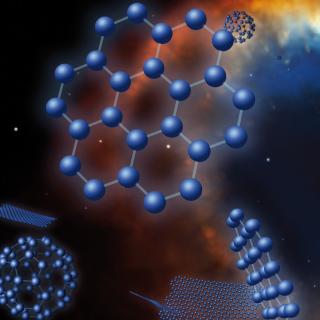García-Hernández, D. A.; Manchado, A.; García-Lario, P.; Stanghellini, L.; Villaver, E.; Shaw, R. A.; Szczerba, R.; Perea-Calderón, J. V.
Referencia bibliográfica
The Astrophysical Journal Letters, Volume 724, Issue 1, pp. L39-L43 (2010).
Fecha de publicación:
11
2010
Número de citas
182
Número de citas referidas
146
Descripción
Hydrogen depleted environments are considered an essential requirement
for the formation of fullerenes. The recent detection of C60
and C70 fullerenes in what was interpreted as the
hydrogen-poor inner region of a post-final helium shell flash planetary
nebula (PN) seemed to confirm this picture. Here, we present strong
evidence that challenges the current paradigm regarding fullerene
formation, showing that it can take place in circumstellar environments
containing hydrogen. We report the simultaneous detection of polycyclic
aromatic hydrocarbons (PAHs) and fullerenes toward C-rich and
H-containing PNe belonging to environments with very different chemical
histories such as our own Galaxy and the Small Magellanic Cloud. We
suggest that PAHs and fullerenes may be formed by the photochemical
processing of hydrogenated amorphous carbon. These observations suggest
that modifications may be needed to our current understanding of the
chemistry of large organic molecules as well as the chemical processing
in space.
Proyectos relacionados

Nucleosíntesis y procesos moleculares en los últimos estados de la evolución estelar
Las estrellas de masa baja e intermedia (M < 8 masas solares, Ms) representan la mayoría de estrellas en el Cosmos y terminan sus vidas en la Rama Asintótica de las Gigantes (AGB) - justo antes de formar Nebulosas Planetarias (NPs) - cuando experimentan procesos nucleosintéticos y moleculares complejos. Las estrellas AGB son importantes
Domingo Aníbal
García Hernández